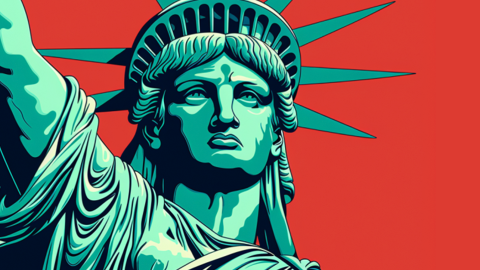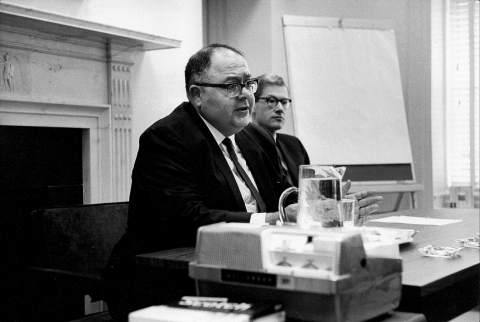A spectre is haunting America, the spectre of TDS. That is the acronym for the plague that is afflicting half of our adult population, more than half if truth be told, and many youngsters whose parents have exposed them to the disease. According to Bernard Goldberg, writing in his column, some victims cry uncontrollably, others faint, others threaten to leave the country, still others hunt for safe spaces in which to display their emotional reaction to Trump Derangement Syndrome. Reports indicate the disease has spread to Britain, so severely afflicting the speaker of the House of Commons that he proposed barring the President of the United States, a man the speaker deems sexist and racist, from addressing Parliament when the President drops in to visit the Queen and, with luck, play her private golf course at her Scottish Balmoral estate.
For politicians and even dispassionate and informed observers of the financial sector, TDS takes a special form: fear of a collapse of the world financial system if Trump succeeds in repealing the 2,300 page Dodd-Frank bank-reform law passed in 2010 in response to the near-collapse of the banking system and the onset of the Great Recession in 2008. Especially since the President is appointing regulators who are unlikely to explore the outer limits of their enforcement authority, apparently on the theory that “Personnel is policy". "Very worrisome" declares Mario Draghi, President of the European Central Bank; "It is difficult not to notice... when an American president talks about 'doing a big number' on Dodd-Frank," adds Valdis Dombrovskis, a vice-president of the European Union, who finds Europe "sensitive to talk about unpicking financial legislation which applies to carefully negotiated international standards and rules." Trump's concern with that sensitivity is likely to be minimal, if he is indeed aware of it.
As with all Trump-induced panics, this one is based on a worry too far. Consider five facts.
* All the President has done so far is issue an executive order setting a few "core principles" such as "empower[ing] Americans to make independent financial decisions" and "foster[ing] economic growth and vibrant financial markets through more rigorous regulatory impact analysis." Not a word about deregulation. Guided by those core principals, the Treasury is to come up with proposals to alter Dodd-Frank.
* It would take 60 votes in the Senate to repeal Dodd-Frank, and Republicans have only 52, enough to repeal a few provisions but not the statute itself. Any such deletions might trigger litigation and judicial review.
* The law called into being some 400 regulations, 80% of which have been implemented and most of which are too deeply embedded in the current system to be removed.
* Most observers agree that Dodd-Frank imposes unnecessarily high compliance costs on small borrowers, both business and personal, and on small community banks. A widely accepted need to lighten those burdens is reason enough to take another look at existing regulation.
* Any new president would want to review the applicability of a seven-year old regulatory regime to a new financial world. Among other things, traditional banks now face heightened competition from non-bank lenders, such as Quicken Loans, boutique advisers such as Evercore, and from online lenders such as SoFi (up to $100,000) and Lending Tree (up to $35,000). Doubt that the ageing statute needs revision? Ask Barney Frank, its co-author, "We wrote this in the wake of a major crisis…. And we've learned a lot since then, and some parts of the law should be changed to reflect that."
"I have so many people, friends of mine, friends that had nice businesses, they can't borrow money," the President said in one of his daily television performances. No doubt, since many of his friends are in the business he says he has turned over to some sort of trust—property development. That sector is characterized by very high borrowings and, as a result, very frequent bankruptcies, including several by various Trump entities. But jumping from the experience of presidential friends to generalization about credit markets can be misleading.
The fact is that bank lending has increased at an annual rate of almost 7 percent since 2013. American companies refinanced $100 billion in loans last month alone. These borrowers were able to obtain lower interest rates because banks were scrambling for customers.
Nevertheless, a review of a statute drafted during a financial panic, and governing a rapidly changing industry is a good idea, and hardly a reason for an outbreak of TDS, either here or in Europe. And more calmly done when big banks are doing quite well, as they are, in part due to Dodd-Frank and additional regulations by the Federal Reserve Board. Their capital positions are stronger than before the financial collapse, their portfolios are less risky thanks to prohibitions on trading with their own capital, they pass the various stress tests imposed by the Fed, and are working to produce so-called "living wills" laying out plans for orderly winding-down should they run into real trouble. This distinguishes our banks from Europe's, which according to Tidjane Thiam, CEO of Credit Suisse, are in a "very fragile situation … [and] not really investible."
But even our strengthened banking system remains lumbered with the old problem of banks "too big to fail". The four largest banks—JPMorgan Chase, Wells Fargo, Bank of America, Citibank, each with close to or more than $2 trillion in assets—control almost half of all the domestic assets of America's more than 5,000 banks.
We are still relying for the stability of the international financial system on institutions that are not only large but interconnected with other financial institutions in ways we do not fully understand -- Lehman Brothers, which triggered the 2008 collapse, was small by the standards of international financial institutions. And on banks that just might be too big to manage, witness the $6.2 billion trading loss incurred by the so-called London Whale under the watchful eyes of the JPMorgan Chase supervisory staff, and the recent scandal that revealed to a shocked, shocked Wells Fargo board that its compensation system drove its salesmen to forge names on new accounts and load existing customers with charges they did not know they had incurred.
There is talk in Washington of three possible solutions to the too-big-to-fail problem. One is to break up the big banks, a view being put about by Neel Kashkari, president of the Federal Reserve Bank of Minneapolis. Another is to increase big banks' capital requirements enough to make failure virtually impossible—perhaps from 7% of assets to 10%, proposed by Jeb Hensarling, chairman of the House Committee on Financial Services. Finally some, among them Elizabeth Warren, the perpetually angry anti-Wall Street Democrat senator from Massachusetts, prefer Trump's campaign suggestion that we resurrect the Glass-Steagall Act to prevent any activity by big banks in risky sectors of the financial markets, stricter than the existing Volcker rule. There appears to be no support for returning to the bad old pre-collapse days by repealing Dodd-Frank, except perhaps, and only perhaps, from the White House branch of the Goldman-Sachs alumni association. Unless banks accept such massive increases in capital requirements as to make them truly too big to fail, without taxpayer intervention.
There is a lesson here for sufferers from Trump Derangement Syndrome. As the recent court decision concerning the administration's botched effort to prevent terrorists from entering the country underscores, our Founding Fathers built a system that makes the wish-fulfillment of an impatient president heavily dependent on the courts and the congress. So take a deep breath and spend some time reading our Constitution and leafing through the Federalist Papers. You'll feel at least a little bit better almost immediately.














